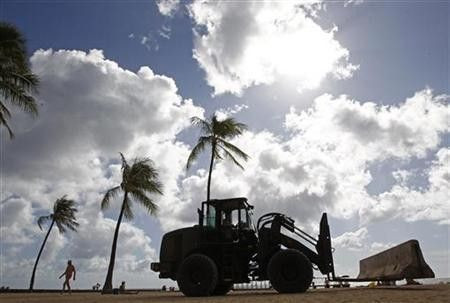Near Pacific Summit Site, Reminder of U.S. Security Role

The wealthy nations attending the Asia-Pacific Economic Cooperation summit in Hawaii may fight over trade, but they've avoided serious armed conflict for decades, and the U.S. Pacific Command aims to keep it that way, even as it copes with budget pressures and a surging China.
The regional prosperity that APEC leaders will celebrate and vow to nurture this weekend in President Barack Obama's native Honolulu owes much to heavy lifting by American military personnel patrolling the vast Pacific Ocean and directed from Hawaii.
We've seen over the past 30-plus years the region really blossom both economically and politically and people tend to forget or not even realize a reason for that is that the United States has ensured stability in Asia and the Asia-Pacific, said Michael Mazza, a security expert at the conservative American Enterprise Institute think tank in Washington.
The Hawaii-based U.S. Pacific Command and the network of alliances it has built up since World War Two kept the Soviet Union and regional rivalries at bay, contributing to the spectacular economic growth of APEC members Japan, South Korea, Taiwan and many Southeast Asian countries.
We've gotten rich as well and we've benefited greatly from economic development in Asia that may not have happened absent the U.S. military presence, said Mazza, co-author of a new study on upgrading the U.S. alliance network for new challenges.
But ironically, China -- the fastest-growing and largest trade partner for most of APEC's 21 member economies -- has benefited greatly from the U.S.-led Asian security architecture, too. That creates an awkward formula in which many Asia-Pacific states look to Beijing for economic growth but to Washington for security.
REASSURANCE ON FISCAL PRESSURES
Based just outside Honolulu where a former U.S. naval hospital built in a sugar cane field overflowed with wounded American troops in 1945, USPACOM covers an area from California to India that is home to five of the world's 10 biggest economies.
USPACOM's area of responsibility comprises half the globe. On any given day, the U.S. Navy has 50 to 60 ships in the region, protecting sea lanes in the South China Sea that carry $5 trillion in commerce annually, including $1.2 trillion in trade with the United States, Admiral Robert Willard, the head of Pacific Command, said in a September interview with Reuters.
Some 325,000 military and civilian personnel, or about one-fifth of total U.S. military strength, serve under USPACOM, including about 80,000 troops stationed in Japan and South Korea, according to command data.
U.S. power and reach is multiplied by formal mutual defense treaties with Australia, Japan, the Philippines, South Korea and Thailand, as well as less formal partnerships with states including Singapore, Indonesia and India.
Lately, Willard and Defense Secretary Leon Panetta have gone to great lengths to reassure allies that the U.S. military will maintain a strong posture in the Pacific despite looming defense spending cuts at home.
Panetta, on his first trip to Asia since taking over the Pentagon's top job in July, said the U.S. military withdrawal from Iraq this year and the gradual drawdown in Afghanistan would enable Washington to refocus on the Asia-Pacific region.
We are not anticipating any cutbacks in this region. If anything we are going to strengthen our presence in the Pacific, Panetta said in Tokyo last month.
CHINA'S PRIORITIES
Fiscal troubles are putting pressure on U.S. military power in the Pacific as China's two decades of nearly unbroken double-digit growth military spending have yielded advances. While still well behind the United States in many respects, its efforts include a nascent aircraft carrier program, prototype stealth fighter jet and anti-ship ballistic missiles.
A study of U.S. alliances produced by a nonpartisan Washington think tank called the Project 2049 Institute says China benefited greatly from U.S. military primacy that contained the Soviet Union and suppressed Asian military rivalries.
The Obama administration would like China to share more of the burden and follow more of the rules of the existing global system that has buttressed its rise. But the report suggested that is unlikely.
China, unlike its Asian peers, does not appear content with the American-made and -dominated international order, said the report, which warned that Beijing's dissatisfaction and ambitions are stoking U.S.-China security competition.
Beijing is neither a candidate for the kind of benign hegemonic rule that others would find legitimate, nor much interested in aiding Washington in shouldering global responsibilities.
A proposal a Chinese Navy officer made to Willard's predecessor, Admiral Timothy Keating, several years ago -- that China and the United States draw a line down the middle of the Pacific Ocean and each control a side -- was brushed off as a tongue-in-cheek remark.
But China's shift in 2010 toward a truculent stance over contested territorial claims in the South China Sea and East China Sea is no laughing matter to leaders who will join Obama in Honolulu and also meet the following week at the East Asian Summit on the Indonesian island of Bali.
For them, a visit to the watery battleship graveyard at nearby Pearl Harbor, some three weeks before the 70th anniversary of the 1941 Japanese attack, would underscore how vital it is to get the rise of a emerging power right.
© Copyright Thomson Reuters {{Year}}. All rights reserved.





















